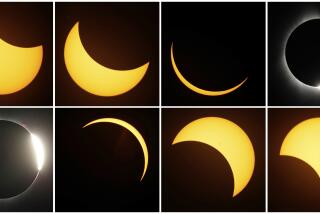‘Cosmos’ recap: The meaning and math of comets
Some of us are old enough to remember the much-ballyhooed appearance of Halley’s comet in 1986 -- it swoops past Earth only once every 76 years, after all, and isn’t due back until 2061. (So mark your calendars!) It also provides a handy framework on which to hang the scientific concepts featured in this week’s episode of “Cosmos: A Spacetime Odyssey.”
It starts with a nod to the human gift for pattern recognition -- both a blessing and a curse, since sometimes we see patterns that aren’t really there, like the face of Jesus in a piece of toast. (The technical term is “pareidolia.”)
We also see patterns and messages in the stars. “We were born into a mystery,” Neil deGrasse Tyson intones over an image of a baby in a basket, gazing up at the night sky as the stars are reflected in the infant’s eyes. We see shapes in the form of constellations, for instance, and past civilizations read dire portents of doom in the periodic appearance of comets streaking across the sky. Chinese astronomers began keeping records of comets around 1400 BC, including one in 240 BC that we now know as Halley’s comet, after the 17th century astronomer Edmund Halley.
VIDEO: ‘Cosmos’ Q&A with Neil deGrasse Tyson and Seth MacFarlane
Halley first observed a comet in 1664. It happened to coincide with the outbreak of the plague in England, as well as the Great Fire of London, but it inspired the young Halley’s love of the night sky. He gained notoriety for his voyage to map the stars of the Southern Hemisphere and soon became part of the vibrant intellectual community that frequented the local coffeehouses, vividly brought to life in another of the series’ clever animated sequences.
During one conversation, Halley offered to pay 40 shillings to the first person to demonstrate a simple mathematical law explaining why the planets move in elliptical orbits rather than perfect circles. But nobody could do the math -- except for Isaac Newton, who was a bit of a recluse by this point thanks to his squabbles with Hooke and many other scientists of that era. Newton was a difficult man. But he was also brilliant. Halley learned that Newton had solved this calculation five years earlier, part of the manuscript he’d been writing: the Principia. Spoiler alert: This is one of the greatest scientific treatises ever written, outlining the laws of motion and the universal law of gravitation, as well as the invention of calculus.
It was just the sort of thing that the Royal Society would publish -- except the society was strapped for cash that year, having blown its budget on a lavishly illustrated tome called “History of Fish” that proved to be a colossal failure in terms of sales. Apparently the society was paying Halley’s salary in copies of books it couldn’t sell, which does make for an amusing domestic scene in which Halley’s wife is dismayed when he comes home with yet another copy of “History of Fish.”
PHOTOS: TV shows and their spinoffs
Long story short: Halley decided to pony up the cash to publish the Principia himself, and a scientific revolution ensued. Newton’s laws explain how nature works, and it does so in the language of mathematics. When mankind sent the first rockets to the moon, it was Newton in the driver’s seat.
Newton was such a towering figure that we tend not to remember his gifted contemporaries -- like Halley, who did not actually discover the comet that bears his name. But he was the first to notice an interesting pattern in comet sightings, after poring over first-hand accounts from several centuries. He realized that the comet recorded in 1682 was the same as the one that had been recorded in 1531 and 1607. It was orbiting the sun in a long elliptical path. Halley predicted the same comet would reappear at the end of 1758 -- and it did.
Alas, this episode doesn’t have the most straightforward storytelling. There are a lot of extraneous details and meandering asides. The temptation to include them is understandable, since this is one of the richest periods of science history, replete with colorful anecdotes and memorable characters engaged in impassioned debates and bitter rivalries. But it does distract from the main points a bit.
For instance, we probably didn’t need a laundry list of every major scientific accomplishment of Oort, Halley and Hooke, impressive as they were. (That said, I was amused to learn that Hooke apparently sampled cannabis, declaring that there was “no cause for fear” with the drug, “but maybe for laughter.”)
We get some tying up of loose ends in the final segment. Hooke died and Newton replaced him as president of the Royal Society and may have destroyed his predecessor’s portrait as a final act of revenge against his rival. Halley died at the ripe old age of 85; legend has it that he called for a glass of wine and drank it before breathing his last. But their intellectual legacy lives on. Tyson gets to wax philosophical now, urging us to “feel the wonder and not the fear” when we contemplate the universe, and marveling at how far human ingenuity has taken us: “The baby in the basket is learning to walk -- and to know the cosmos.”
You’d think that would wrap things up nicely -- but wait, there’s more!
Newton’s laws make it possible to predict the fate of our own Milky Way galaxy, which will someday, in the far future, merge with the Andromeda galaxy, giving rise to a “billion-year-long light show.” This galactic merger scene seemed oddly tacked on and might have worked better just before Tyson’s philosophical ruminations. But it does reinforce the magnitude of Newton’s achievement. Perhaps the episode should have ended with this immortal couplet penned by Alexander Pope:
Nature and Nature’s laws lay hid in night;
God said, Let Newton be! And all was light.
ALSO:
‘Cosmos’ recap: Starts with a big bang
‘Cosmos’ recap: Wading into the tide pools of evolution
Review: Neil deGrasse Tyson’s ‘Cosmos’ a fascinating, fun place to be
More to Read
The complete guide to home viewing
Get Screen Gab for everything about the TV shows and streaming movies everyone’s talking about.
You may occasionally receive promotional content from the Los Angeles Times.






